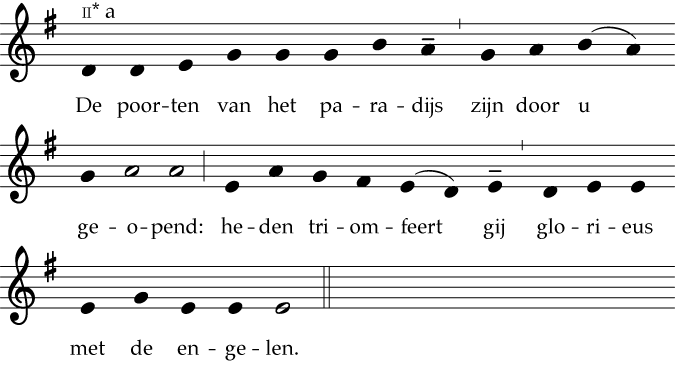What's with mode IV A / II* ?
-
In the Klein Graduale (www.kleingraduale.nl), a Dutch adaptation of the Graduale Simplex, I'm using modern musical notation. What's the best way to typeset antiphons of mode IV A / II*, like Paradisi portæ:

1. Using a key signature with one sharp:
2. Using an accidental, like Paul Ford does in By Flowing Waters:
Right now I get mixed advices, both ways being promoted with the organist in mind who wants to accompany the chant.
And as an aside: why did Solesmes rename the mode from IV "Alteratus" to II* in the early '80s? -
Your last question informs the first...
Which mode would you like the organist to favor? II or IV?
If we label the chant as "IV A", then there is a b2 scale degree, being that it is mode IV ... and then there is the "altered" note when the natural 2nd appears. If you want the organist to favor the sound of mode IV (with the F-natural, in this key), then I'd use the second option, with the accidental.
If we label it as "II*", then it has that F# all the time, so I'd use the key signature if you want the organist favoring a mode II flavor.
As another aside, why did they add the asterisk? Reading through it, I would have labelled it mode II from the start. I'm curious why they called it anything else to begin with, and when it was "re-labelled" to II*, what does the asterisk indicate? Seems like mode II to me. -
From this example, I don't understand why this mode was ever labelled mode IV. It doesn't appear or sound like there's anything Phrygian about it. It certainly sounds like Mode II, albeit transposed, ending on la instead of re - so I'm assuming that's the reason for the *. (If it were written in regular mode II, ending on re instead of la, the lowest note would have to be ti-flat - and it would look rather weird having a flat that low on the staff.)
And so, because it sounds like mode II transposed up a fifth, I favor the key signature in modern notation - because that is indeed what happens when you transpose up a fifth. -
As to the mode: this is one of a family of antiphons that have more or less the same melody. They're all notated with a final on A. Some of them (like Laeva ejus [LU p. 1258], In odorem [LU p. 1606], and Apud Dominum misericordia [LU p. 412]) have a B-flat (or two) in the last phrase, while others (like the example above) skip over the B in the last phrase.
So Paradisi porta could reasonably be mode II, but other members of the family give a strong argument for mode IV. And yet, it's clearly the same tune, so it makes sense to assign them all to the same mode...
As to signature: as Ryan says, if you're planning to use mode IV for the psalm tone, no key signature, F-sharp accidental at 'triomfeert'. If you're planning on mode II, put the sharp in the signature (or better yet, transpose it down a fifth, to mode II's natural final of d.)
(I favor mode IV, partly because of the F at 'angelis', but your Dutch version has already taken a step closer to mode II by not going down to the c-natural at 'glorieus'.)
Bill McJohn
Thanked by 1SkirpR -
Makes sense Bill, thanks!
Welcome to the MusicaSacra Forum!
To participate in the discussions on Catholic church music, sign in or register as a forum member, The forum is a project of the Church Music Association of America.
Categories
- All Discussions21,124
- General Music Discussion7,602
- Job Openings1,309
- Management of Music Programs833
- Choral Matters519
- Church Documents and Rubrics504
- CMAA Notes291
- Events651
- For Newcomers: Read First23
- Sacred Polyphony529
- Hymnody821
- Gregorian Chant: General2,583
- ↳ Graduale Romanum and Liber Usualis354
- ↳ Graduale Simplex55
- ↳ Semiology57
- Vernacular Plainsong671
- Anglican Use and Anglican Chant66
- Organ, Other Instruments and Repertoire414
- New Composition/Works in Progress1,208
- Recordings222
- Music for Hispanic Ministry151
- Music Education: Children205
- Music Education: General214
- News Items242
- Positions Wanted58
- General Discussion: Catholicism723
- Amusements171
- General Discussion1,001
- Opinions113



